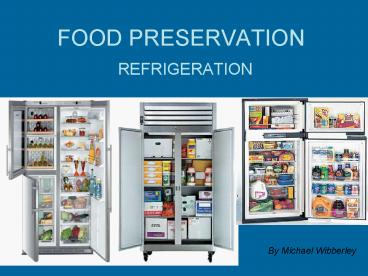FOOD PRESERVATION - PowerPoint PPT Presentation
1 / 12
Title:
FOOD PRESERVATION
Description:
And then maintaining that lower temperature. Heat Transfer Convection Conduction or ... waste and spoilage of food products - higher than needed energy bills ... – PowerPoint PPT presentation
Number of Views:384
Avg rating:3.0/5.0
Title: FOOD PRESERVATION
1
FOOD PRESERVATION
- REFRIGERATION
By Michael Wibberley
2
- Definition
- Refrigeration is the process of removing heat
from a enclosed space (refrigerator), and
rejecting it elsewhere for the primary purpose of
lowering the temperature of the enclosed space.
And then maintaining that lower temperature.
3
Heat Transfer Convection
Conduction or Radiation
- Refrigeration consists of three basic methods
- -Convection is one of
- the major modes of heat
- transferring convection is
- Known as movement of
- currents within fluids.
- This process is better known
- as advected (carried) meaning
- heat is transported by the larger
- scale motion of the currents in
- the fluids.
- Conduction Is the spontaneous
- transfer of thermal energy through
- matter, from one region of higher
- temperature to a region of lower
- temperature, and acts to even out
- temperature differences.
-Heat transfer is the passage of thermal energy
from a hot to a colder body. e.g. liquid to
solid, hot to cold
4
Does refrigeration stop your food from spoiling?
- Refrigeration can not stop micro-organisms from
spoiling food, however the cooling of food in the
fridge stops the organisms from spoiling any
further. The fridge slows down the process but
does not kill or get rid of the bacteria already
living on the food.
5
The refrigerator works best on food products that
are sealed and not already on their way to
spoiling. Refrigeration does not work best on
food in big pots or big portions, they should be
divided up into smaller portions for safer
storage. The temperature of the refrigerator
should be 40 F or below throughout the cabinet
for safe food storage everywhere in the fridge.
Raw meat, poultry, and sea food should be sealed
in containers, and securely wrapped to prevent
contamination of other foods.
6
Facts From The FDA(food and drug administration)
- Preservation of food products is not only of
economic importance, it is an issue of public
health. The FDA estimates that annually some
40-80 million people become ill and 11 thousand
die in the United States as a result of something
they ate. Medical expenses to treat these cases
are estimated at 80 billion. The cost to a food
service company is between 1,500 and 78,000 to
defend and settle a food borne illness claim.
Food products are all subject to deterioration by
microorganisms.
7
Micro-organisms are ubiquitous (widely present)
in the refrigerator, they are reintroduced
constantly by new food products, containers, and
people in and out of the fridge. It is absolutely
impossible to maintain a micro-organism free
refrigerator. That is why it is necessary to
control what goes in and out of the fridge, and
to clean regularly to maintain a safe as possible
refrigerated storage environment.
8
In the kitchen the refrigerator is the most
important piece of equipment when it comes to
food products. It works harder and longer then
any other appliances. Unlike the microwave, the
oven, and coffee pot the fridge must work 24
hours to keep your food safe. The refrigerator is
also the most misunderstood piece of equipment in
the kitchen, because failing to maintain your
refrigerator will result in economic losses such
as - waste and spoilage of food products -
higher than needed energy bills - dissatisfied
customers for food industries - and potential
food borne illness claims.
9
Shelf life
Definition - Shelf life is a catch-all term for
the chemical, biochemical, microbiological,
sensorial, and nutritional stability of foods and
beverages.
- In other words how long food products can stay on
a shelf or at room temperature without being
sealed and still be healthy to eat. - Example donuts at Tim's, candies in a store (not
sealed) - This also refers to hot foods that must maintain
a certain high temperature to - Stay fresh and also be healthy to eat.
- Example soup, hot meats
10
Advantages of using a refrigerator
- To keep certain products within the kitchen such
as dairy products, meat, fish, poultry, and
vegetables. - Raw meat should be kept separate from other food
products for reasons of hygiene - Definition Hygiene (maintenance of healthy and
healthy living)
- Storing food products from one day to another,
or hold onto a food if have not had time to eat
yet.
11
Disadvantages of using a refrigerator
- Water vapour from the air of the refrigerator
condenses onto the cooling coils, which results
in a thick layer of ice. This ice acts as an
insulator, reducing cooling efficiency.
- The refrigerator only keeps food products and
beverages good for so long after a while they do
begin to spoil.
12
Bibliography
- http//en.wikipedia.org/wiki/Refrigeration
- http//en.wikipedia.org/wiki/Heat_transfer
- http//en.wikipedia.org/wiki/Convection
- http//www.humitrol.com/refriger.htm
- http//en.wikipedia.org/wiki/RefrigeratorThe_impa
ct_of_the_refrigerator_on_the_home































